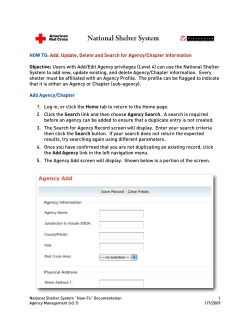
Shelter Voices - Canadian Network of Women`s Shelters and
ON ONE DAY, 231 SHELTERING ORGANIZATIONS ACROSS CANADA RECORDED HOW MANY WOMEN AND CHILDREN THEY HELPED SHELTER VOICES A day in the life of Canada’s shelters for women survivors of abuse With responses from shelters representing every province and territory in Canada, Shelter Voices 2015 seeks to amplify the voices of shelter workers and the women and children they serve. Beyond just a safe place to stay, shelters and shelter workers provide a range of services, resources, and supports that allow women to grow and thrive as survivors. Using the information and insights gathered in this survey, we are bringing attention to the important work that is taking place while also highlighting the gaps needing to be addressed. Through the voices and first hand experiences of frontline workers and the women and children who seek refuge in shelters, we can see how shelters are shaping the future together to enable women and their children to see themselves as survivors rather than victims. ON ONE DAY, 231 SHELTERS WELCOMED 122 NEW WOMEN AND 81 NEW CHILDREN. ON THE SAME DAY, 302 WOMEN AND 221 CHILDREN HAD TO BE TURNED AWAY DUE TO LACK OF RESOURCES. April 2015 Although not all shelters record this information, Of the women helped, 114 were known to be pregnant and 110 had been threatened with a gun PROFILE OF PARTICIPATING SHELTERS ON ONE DAY, 231 SHELTERS IN CANADA HELPED 3,781 WOMEN AND 2,508 CHILDREN. Of the participating shelters, 81% are emergency/first-stage shelters, 10% are second stage shelters, and 9% identify as a mix of other shelter accommodation. “This is satisfying work, even though you may never see a finish line.” “Our strength is working as a team in our interventions with women victims of violence” “I am always happy to see a woman and her children make a fresh start on their own, away from the abuser.” PREVENTION Prevention is an essential part of ending violence against women. In addition to their work sheltering and supporting women and their children, 94% of shelters included in the study take part in prevention initiatives. 79% provide education or training to service providers 63% of shelters carry out school based programs 25% of shelters do work with men 90% initiate public awareness campaigns “We have the opportunity to provide women with knowledge and support to navigate through systems. The ongoing use of empathy, validation and compassion allows the woman to be in control of her journey.” Shelter workers provide a multitude of services that are far too often not recognized. Through their work and expertise, they allow women to see themselves as survivors rather than victims. Their testimonials best convey the scope of their work and their deep commitment. “Listening remains the most important key for helping women to feel understood and believed. Despite everything, when these women have someone to accompany them in their journey it gives them a chance to move in a more positive direction because they feel supported.” “The issues women are dealing with are complex. If a woman can find that one spark that will help the negativity stop ...and begin slowly to build herself back up then we are conduits for that process and we are supporting her healing.” “We feel that we truly make a difference and open up new horizons. We build relationships of trust and openness. We respect every woman’s pace and we don’t judge.” The needs of women seeking shelter services are increasingly complex. Shelter workers have identified the need to better equip themselves to serve women with substance use and mental health concerns. Fewer than 20% of shelters said they felt “well equipped” to help women with mental health concerns. Just 31% of shelter workers said they felt well equipped to help women with substance use concerns. Here are some of their ideas: They identified strategies to improve capacity: “Adequate and accessible resources to refer clients according to their needs. We often have women who 'fall through the cracks' due to lack of resources. Or if there are resources, they have long waitlists and many of the women end up leaving the shelter poorly resourced.” “More training for front line staff so that they feel more comfortable in that role.” “Funding to increase staffing levels and/or funding to hire a mental health counsellor.” Specialized mental health and addictions training for staff An on site addictions worker More community based programs available to women (e.g. detox or addiction centres) Shorter wait times for detox and substance use programs Safe harm reduction options for women fleeing abuse "Above all the struggles and hardships, I have found hope and self worth." SUPPORTS AND SERVICES The most in demand services and supports offered to women in shelters by external organizations: Housing Income Assistance Legal Aid SURVIVOR VOICES: IN THEIR OWN WORDS “I am leaving the transition house with confidence and the ability to stand up and take my life back.” “I can recall feeling extremely worried, scared, alone, hopeless and lost when I first got here. I only had my daughters and one girlfriend. No family support. Thanks to the hard work of each and every one of your wonderful staff members, I was able to build up strength. I CAN PROUDLY SAY I’M NO LONGER A VICTIM OF ABUSE! I would like to thank all of the staff for touching my life in an amazing way. It is amazing knowing if I’m just one woman they’ve helped. Look what they have done for so many others.” “I thought I would never be able to speak my mind. Thanks to shelter staff I have my voice back." “I never knew that I could feel safe again.” “We are in a magical house.” –a child’s words “I learned how to feel, set boundaries, have self-esteem, and be independent. It became our safe haven where everyone was treated with respect. I always think of the shelter as the stepping stone to my future... without it, there might have been no future at all.” EXPERT ADVICE FROM SHELTER WORKERS We asked shelter workers what they would change to make things better for abused women and their children. An overwhelming number of responses focused on the need for a more integrated network of support services for women and children beyond their shelter experience. These include access to safe and affordable housing options (including second-stage housing) and higher rates of income assistance. Shelters and transition houses play a pivotal role in the lives of women and children fleeing abuse. Together, they are shaping a better future. Shelter Voices is produced by the Canadian Network of Women’s Shelters and Transition Houses, a coalition of 12 provincial and territorial shelter networks representing over 350 shelters across Canada. The network works as a unified voice to collaborate, educate, and innovate for systemic change that ends violence against women, making Canada a model for safety in the world. The CNWSTH thanks the National Union of Public and General Employees and Justice Canada for their contribution to Shelter Voices. Printing provided by the Canadian Union of Postal Workers. Visit our website www.endvaw.ca and find us at facebook.com/endvawnetwork
© Copyright 2025











